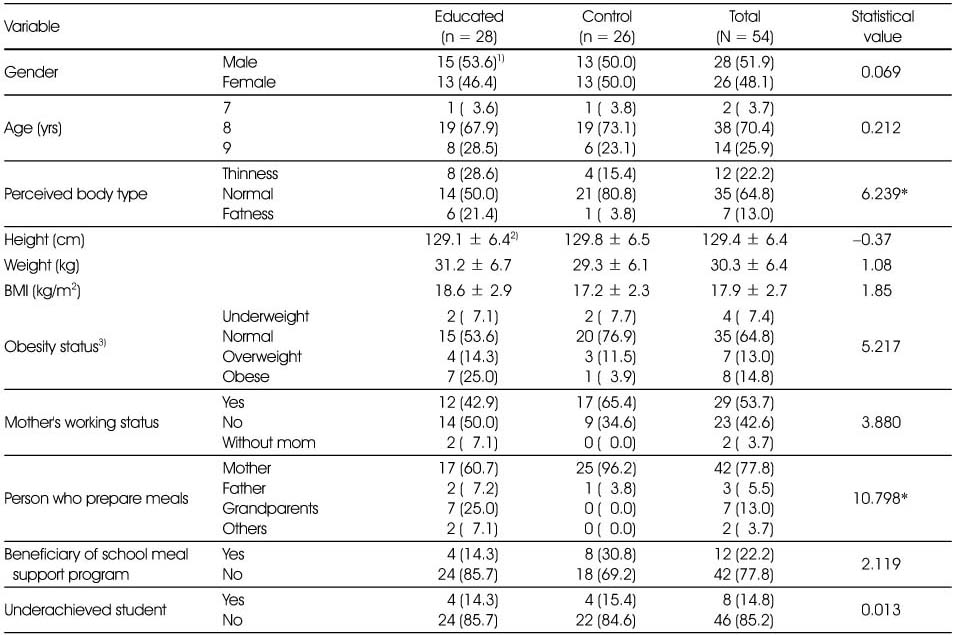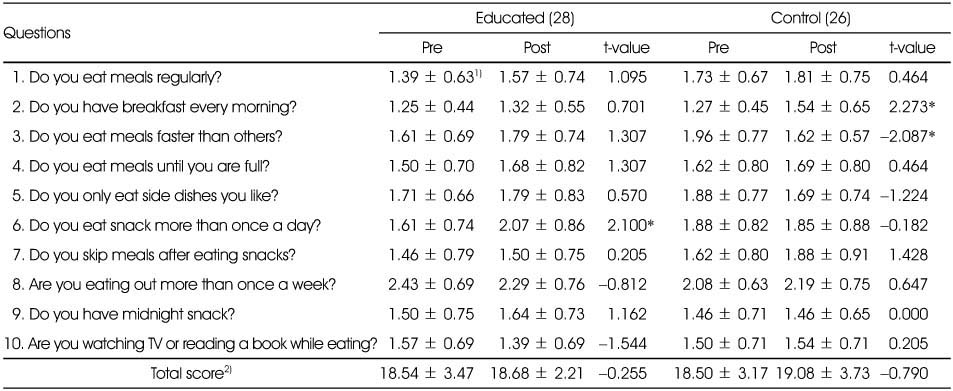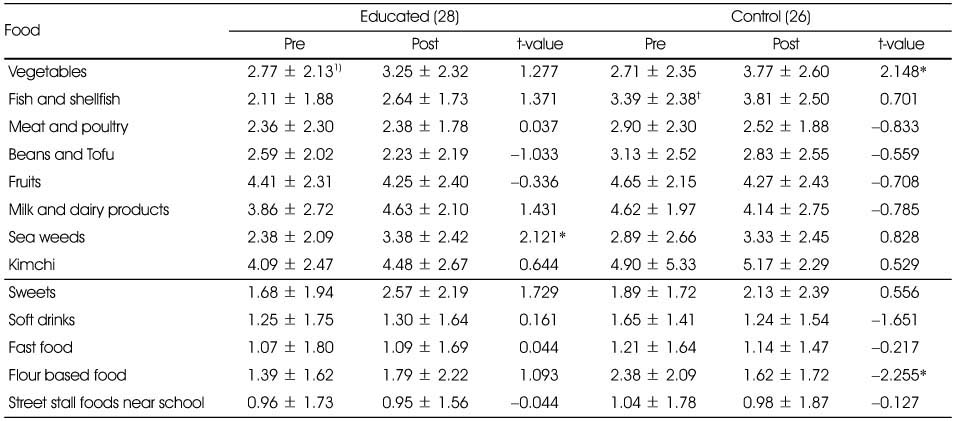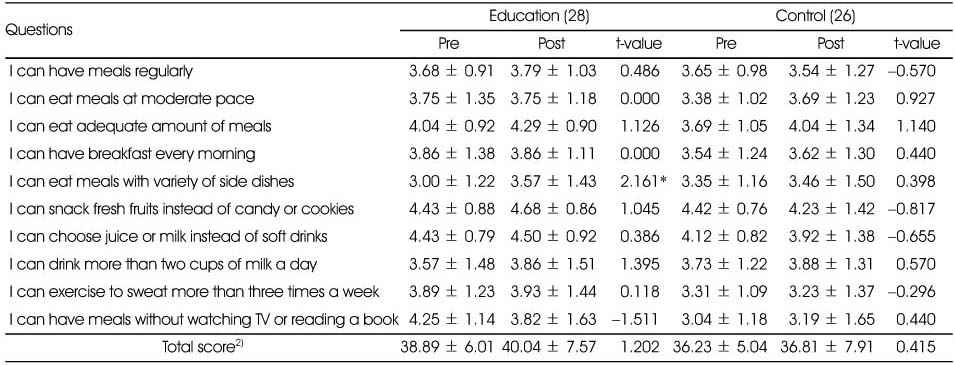Articles
- Page Path
- HOME > Korean J Community Nutr > Volume 16(2); 2011 > Article
-
Original Article
- Evaluation of a Nutrition Education Program for 3rd Grade Elementary School Students
- Duk Ha Kwon, Sung Nim Han, Hye-Kyeong Kim
-
Korean Journal of Community Nutrition 2011;16(2):183-194.
DOI: https://doi.org/10.5720/kjcn.2011.16.2.183
Published online: April 30, 2011
Nutrition Education, Graduate School of Education, The Catholic University of Korea, Bucheon, Korea.
1Department of Food and Nutrition, Seoul National University, Seoul, Korea.
2Department of Food Science & Nutrition, The Catholic University of Korea, Bucheon, Korea.
- Corresponding author: Hye-Kyeong Kim, Department of Food Science & Nutrition, The Catholic University of Korea, 43-1 Yeokgok 2-dong, Wonmi-gu, Bucheon, Gyeonggi-do 420-743, Korea. Tel: (02) 2164-4314, Fax: (02)2164-4314, hkyeong@catholic.ac.kr
Copyright © 2011 The Korean Society of Community Nutrition
- 927 Views
- 5 Download
- 7 Crossref
Figure & Data
REFERENCES
Citations

- Effect of Nutrition Education on Reduced Sugar Intake in Elementary School Students
Young-Mi Seo, Ok-Jin Park, Min-June Lee
Journal of the East Asian Society of Dietary Life.2021; 31(1): 14. CrossRef - Status of Dietary Life Related Knowledge, Self-Efficacy, Food Preference and Dietary Behavior of Preschoolers in Kyunggi Area
A Reum Lee, Ye Lee Yu, Hye Jin Kim, Kyung A Kim, Kyung Won Kim
Korean Journal of Community Nutrition.2016; 21(3): 274. CrossRef - Effectiveness Evaluation of Food Allergy Education Program for Elementary School Children
Harim Kim, Kyunghee Song, Youngmi Lee, Youngshin Han, Bomi Kang, Soun Ju Kweoun
Journal of the East Asian Society of Dietary Life.2015; 25(6): 1058. CrossRef - Effects of Dietary Education on Elementary Children in After-school Program in Seoul
Kyung-Hee Kim
Journal of the Korean Society of Food Culture.2014; 29(2): 222. CrossRef - Perception on Nutrition Labeling of the Processed Food among Elementary School Students and Parents in Daegu Area
Jung Mi Kim, Mi Hee Lee, Nan Hee Lee
The Korean Journal of Food And Nutrition.2014; 27(6): 1107. CrossRef - Relationships between Eating Behavior, Dietary Self-Efficacy, and Nutrition Knowledge of Elementary School Students by Food Service Type in Gangwon Province
Hyang-Rye Won, Gi-Beum Shin
Journal of the Korean Society of Food Science and Nutrition.2012; 41(5): 638. CrossRef - Effects of Short-Term Food Additive Nutrition Education Including Hands-on Activities on Food Label Use and Processed-Food Consumption Behaviors: among 5th Grade Elementary School Students
Ji-Hye Kim, Seungmin Lee
Korean Journal of Community Nutrition.2011; 16(5): 539. CrossRef
Summary of nutrition education program
General characteristics of the subjects
*: p < 0.05
1) N (%)
2) Mean ± SD
3) Obesity status by BMI percentiles for age: Underweight: < 5th percentiles, normal: 5th~85th percentiles, overweight: 85th~95th percentiles, obese:= 95th percentile
Comparison of nutrition-related knowledge before and after receiving nutrition education
*: p < 0.05, **: p < 0.01, ***: p < 0.001 by paired t-test
†: p < 0.05, ††: p < 0.01 by t-test (group difference)
1) Mean ± SD
2) Possible total score ranged from 0 - 13 points, each item was scored (1=correct or 0=incorrect)
Comparison of eating habits before and after receiving nutrition education
*: p < 0.05, **: p < 0.01, ***: p < 0.001 by paired t-test
†: p < 0.05, ††: p < 0.01 by t-test (group difference)
1) Mean ± SD
2) Possible total score ranged from 10 - 30 points. Each item was scored (3 = yes, 2 = often, 1 = no) and item 3, 4 ,5, 7, 8, 9, 10 were scored reversely
Food consumption frequency before and after receiving nutrition education
*: p < 0.05 by paired t-test
†: p < 0.05 by t-test (group difference)
1) Mean ± SD, Each food item was scored by 5 scales (7 = every day, 5.5 = 5~6 times a week, 3.5 = 3~4 times a week, 1.5 = 1~2 times a week, 0 = rarely)
Comparison of self-efficacy before and after nutrition education
*: p < 0.05 by paired t-test
1) Mean ± SD
2) Possible total score ranged from 10 - 50 points. Each item was scored by 5-point scales ranging from 'strongly agree' (5) to 'strongly disagree' (1)
Comparison of school lunch leftover between control and educated groups
*: p < 0.05, **: p < 0.01, ***: p < 0.001
1) Mean ± SD
*: p < 0.05 1) N (%) 2) Mean ± SD 3) Obesity status by BMI percentiles for age: Underweight: < 5th percentiles, normal: 5th~85th percentiles, overweight: 85th~95th percentiles, obese:= 95th percentile
*: p < 0.05, **: p < 0.01, ***: p < 0.001 by paired t-test †: p < 0.05, ††: p < 0.01 by t-test (group difference) 1) Mean ± SD 2) Possible total score ranged from 0 - 13 points, each item was scored (1=correct or 0=incorrect)
*: p < 0.05, **: p < 0.01, ***: p < 0.001 by paired t-test †: p < 0.05, ††: p < 0.01 by t-test (group difference) 1) Mean ± SD 2) Possible total score ranged from 10 - 30 points. Each item was scored (3 = yes, 2 = often, 1 = no) and item 3, 4 ,5, 7, 8, 9, 10 were scored reversely
*: p < 0.05 by paired t-test †: p < 0.05 by t-test (group difference) 1) Mean ± SD, Each food item was scored by 5 scales (7 = every day, 5.5 = 5~6 times a week, 3.5 = 3~4 times a week, 1.5 = 1~2 times a week, 0 = rarely)
*: p < 0.05 by paired t-test 1) Mean ± SD 2) Possible total score ranged from 10 - 50 points. Each item was scored by 5-point scales ranging from 'strongly agree' (5) to 'strongly disagree' (1)
*: p < 0.05, **: p < 0.01, ***: p < 0.001 1) Mean ± SD

 KSCN
KSCN







 PubReader
PubReader Cite
Cite


